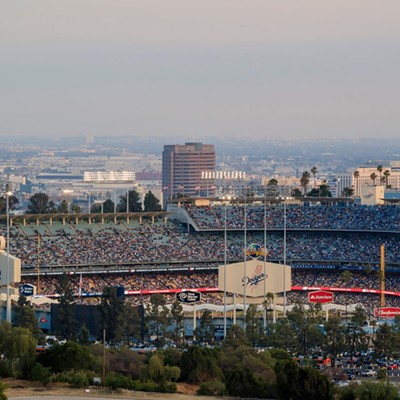The Rincon Heights Neighborhood in Tucson is due south of the University of Arizona football stadium and can be located from the International Space Station at night simply by spotting the gigantic block-letter "A" that blasts photons from the back of the UA's new $6 million scoreboard/mega-video-screen/deafness-inducer.
Not surprisingly, the Rincon Heights folks are none too pleased with the scarlet (and blue ... and white) letter, and they want the UA to do something about it, like maybe turn it off on the 359 nights per year when there is no game going on in the stadium. (It's been on from 7 to 11 p.m. every night, and it should be noted that the UA is not subject to any local sign and light codes.)
I drove by the thing the other night, and it does grab one's attention. It's like that episode of Seinfeld in which a fried-chicken restaurant opens across the street from Jerry's building, and the light from the store's sign is so bright that it keeps Kramer up all night. Jerry is skeptical, so he trades places with Kramer for a night. In the next scene, Jerry staggers out of an incredibly backlit apartment and mutters, "I'm on no sleep ... NO SLEEP!"
The complaints about the light follow many complaints about the noise level generated by the technological marvel/work of the devil. I've heard from many people who have attended football games this season that the noise level from that thing is absolutely overpowering. It has chased many people away, including, apparently, the entire Arizona defensive unit.
I've never actually experienced the scoreboard from regular stadium seating. I can tell that it's really loud as I walk toward the stadium, but in the press box, we can't really hear it as much as feel it. For those of you from Southern California, it feels like an aftershock. Or maybe it's like when one of those never-gonna-get-a-girl-in-his-entire-life guys drives by in an old Honda with box speakers that cost more than the entire car. (University of Arizona athletic director Greg Byrne says that they're in the process of fine-tuning the sound.)
Don't envy me because I sit in the press box. It's freakin' freezing in there! I think the permanent temperature setting in there is "fjord." At the start of September games, when they announce that the game-time temperature is 93 degrees, I feel bad for the folks on the east side of the stadium, who are staring into the setting sun and baking in the heat. By the middle of the second quarter, I want to trade places with them. By halftime, I'm afraid I'm going to end up like the members of the Shackleton expedition.
Back when I was in college, I did a study on whether the concentrated crowd noise coming out of the horseshoe-shaped stadium could do structural damage to the UA library (and its many windows). It turns out that crowd noise made up of tens of thousands of different voices is not as potentially harmful as one voice turned up really loud. (Exhibit A: Michele Bachmann.)
It really doesn't matter anyway, because the university is going to be enclosing the north end of the stadium with a shrine to the football gods.
Don't get me wrong; college football is probably my all-time-favorite sport to follow, but there is an out-of-control arms race throughout the NCAA (of which the scoreboard is but a tiny example) that is threatening to bring it all crashing down. All of the money that is being spent hasn't improved the quality of play, and any enhancement of the fan experience is miniscule, at best.
Back to the scoreboard: Tucson City Councilmember Steve Kozachik finds himself in a unique situation. He not only represents the Rincon Heights Neighborhood on the City Council; he is also the associate director of athletics for facilities and project management for the UA.
Kozachik says that he contacted Buell Jannuzi of the National Optical Astronomy Observatory, which is the United States research-and-development center for ground-based nighttime astronomy. For decades, the NOAO has been working to limit the amount of light pollution that inhibits nighttime astronomy (most notably, the pollution from Tucson that has a negative impact on the work done at Kitt Peak).
Luminance is measured in nits, with one nit being the equivalent of one candela (the measure of luminous intensity) per square meter. Jannuzi tested the scoreboard's giant A, and determined that the blue color was only 15 nits; the red was 25 nits; and the white was 175 nits. (By comparison, computer monitors have an average luminance of around 250 nits, and high-definition TVs go up to 1,000 nits.)
Jannuzi went so far as to comment, "Anything under 100 nits is great, and 175 is not unexpected for white internally illuminated signs—and not unreasonably bright. My thanks to those (who) designed/built/installed it."
So there you have it, Rincon Heights folks: The sign really isn't that bright, so you should just ignore it.
For his part, Kozachik went to Byrne with your request that the sign be shut off at 10 p.m., and they're actually going to trump your offer and have it turned off at 9 p.m.
See, who says we can't all just get along?







